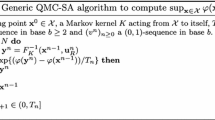Abstract
The classical version of simulated annealing is based on a cooling schedule. Generally, the initial temperature is set such that the acceptance ratio of bad moves is equal to a certain value χ0. In this paper, we first propose a simple algorithm to compute a temperature which is compatible with a given acceptance ratio. Then, we study the properties of the acceptance probability. It is shown that this function is convex for low temperatures and concave for high temperatures. We also provide a lower bound for the number of plateaux of a simulated annealing based on a geometric cooling schedule. Finally, many numerical experiments are reported.
Similar content being viewed by others
References
E. Aarts, J. Korst, and P. van Laarhoven, “Simulated annealing,” in Local Search in Combinatorial Optimization, E.H.L. Aarts and J.K. Lenstra (Eds.), John Wiley and Sons, Ltd., 1997, pp. 91–120.
E. Bonomi and J.-L. Lutton, “The N-city traveling salesman problem: Statistical mechanisms and the metropolis algorithm,” SIAM Review, vol. 26, pp. 551–568, 1984.
V. Cerny, “A thermodynamical approach to the traveling salesman problem: An efficient simulated algorithm,” Journal of Optimization Theory and Applications, vol. 45, pp. 41–51, 1985.
H. Cohn and M. Fielding, “Simulated annealing: Searching for an optimal temperature schedule,” SIAM J. Optim, vol. 3, pp. 779–802, 1999.
L. Grover, “A new simulated annealing algorithm for standard cell placement,” in Proc. IEEE ICCAD-86, Santa Clara, CA, 1986.
B. Hajek, “Cooling schedules for optimal annealing,” Math. Oper. Res., vol. 13, pp. 311–329, 1988.
D.S. Johnson, C.R. Aragon, L.A. McGeoch, and C. Schevon, “Optimization by simulated annealing: An experimental evaluation; part I, graph partitioning,” Operations Research, vol. 37, pp, 865–892, 1989.
D.S. Johnson, C.R. Aragon, L.A. McGeoch, and C. Schevon, “Optimization by simulated annealing: An experimental evaluation; part II, graph coloring and number partitioning,” Operations Research, vol. 39, pp. 378–406, 1991.
D.S. Johnson and L.A. McGeoch, “The traveling salesman problem: A case study,” in Local Search in Combinatorial Optimization, E.H.L. Aarts and J.K. Lenstra (Eds.), John Wiley and Sons, Ltd., 1997, pp. 215–310.
S. Kirkpatrick, C.D. Gelatt, and M.P. Vecchi, “Optimization by simulated annealing,” Science, vol. 220, pp. 671–680, 1983.
N.A. Metropolis, A. Rosenbluth, M. Rosenbluth, A. Teller, and E. Teller, “Equation of state calculations by fast computing machines,” J. Chem. Phys, vol. 21, pp. 1087–1092, 1953.
D. Mitra, F. Romeo, and A.L. Sangiovanni-vincentelli, “Convergence and finite-time bahavior of simulated annealing,” Advances in Applied Probability, vol. 18, pp. 747–771, 1986.
F. Romeo and A.L. Sangiovanni-Vincentelli, “A theoretical framework for simulated annealing,” Algorithmica, vol. 6, pp. 302–345, 1991.
P. Van Laarhoven and E. Aarts, Simulated Annealing: Theory and Applications, D. Reidel Publishing Company, 1988.
J. Varanelli, “On the acceleration of simulated annealing,” PhD Dissertation, University of Virginia, 1996.
S. White, “Concepts of scale in simulated annealing,” in Proc. IEEE Int. Conference on Computer Design, Port Chester, 1984.
Author information
Authors and Affiliations
Rights and permissions
About this article
Cite this article
Ben-Ameur, W. Computing the Initial Temperature of Simulated Annealing. Computational Optimization and Applications 29, 369–385 (2004). https://doi.org/10.1023/B:COAP.0000044187.23143.bd
Issue Date:
DOI: https://doi.org/10.1023/B:COAP.0000044187.23143.bd




